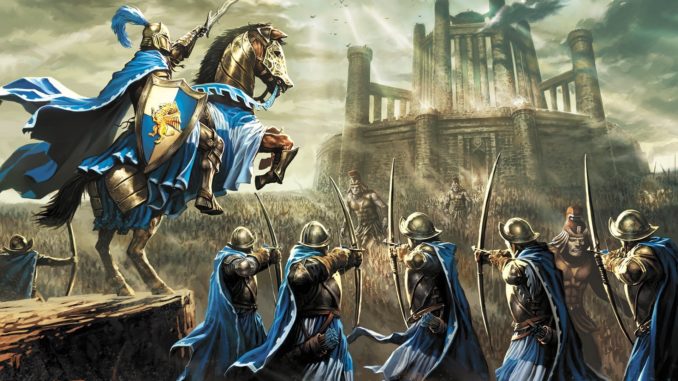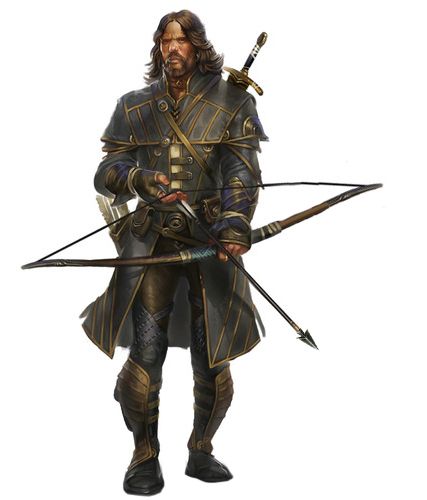
Welcome to part two of this three part series that was written as additional follow up to the piece I did about mechanics not defining your character in Dungeons and Dragons 5th Edition. This week we’re going to take a look at another fighter build that promises to play very different from the dwarven knight I offered last week.
Theodoric

Human Fighter (Battle Master) 3
Armor Class 14 (leather)
Hit Points 28 (3d10+6)
Proficiency Bonus +2
Speed 30 ft
Alignment neutral good
Languages Common, Elvish
Ability Scores
Strength 14 (+2)
Dexterity 16 (+3)
Constitution 15 (+2)
Intelligence 11 (+0)
Wisdom 13 (+1)
Charisma 9 (-1)
Attacks
Melee Attack: Longsword +4 1d8+2 slashing damage, 1d10+2 slashing damage if used two-handed.
Melee Attack: Shortsword +5 1d6+2 piercing damage. Light, finesse
Melee or Ranged Attack: Handaxe +4 1d6+2 slashing damage. Light, thrown (range 20/60)
Ranged Attack: Longbow +7 1d8+3 piercing damage. Ammunition (range 150/600), heavy, two-handed
Skills Acrobatics +3, Animal Handling +3, Arcana +0, Athletics +4, Deception -1, History +0, Insight +1, Intimidation -1, Investigation +0, Medicine +1, Nature +0, Perception +3, Performance -1, Persuasion -1, Religion +0, Sleight of Hand +3, Stealth +3, Survival +3
Equipment leather armor, longbow, quiver of 20 arrows, longsword, shortsword, 2 handaxes, explorer’s pack, staff, hunting trap, preserved bear paw on a necklace, set of traveler’s clothes, belt pouch w. 10 gp
Class Features
Fighting Style (Archery). You gain a +2 bonus to attack rolls you make with ranged weapons.
Second Wind. You have a limited well of stamina that you can draw on to protect yourself from harm. On your turn, you can use a bonus action to regain hit points equal to 1d10 + 3. Once you use this feature, you must finish a short or long rest before you can use it again.
Action Surge. You can push yourself beyond your normal limits for a moment. On your turn, you can take one additional action on top of your regular action and a possible bonus action. Once you use this feature, you must finish a short or long rest before you can use it again.
Combat Superiority. You learn maneuvers that are fueled by special dice called superiority dice. You learn three maneuvers of your choice. Many maneuvers enhance an attack in some way. You can use only one maneuver per attack. You learn additional maneuvers as you gain higher levels. Each time you learn new maneuvers, you can also replace one maneuver you know with a different one. You have four superiority dice, which are d8s. A superiority die is expended when you use it. You regain all of your expended superiority dice when you finish a short or long rest. You gain additional superiority dice at higher levels. Some of your maneuvers require your target to make a saving throw to resist the maneuver’s effects. The saving throw DC is 13.
–Distracting Strike. When you hit a creature with a weapon attack, you can expend one superiority die to distract the creature, giving your allies an opening. You add the superiority die to the attack’s damage roll. The next attack roll against the target by an attacker other than you has advantage if the attack is made before the start of your next turn.
–Maneuvering Attack. When you hit a creature with a weapon attack, you can expend one superiority die to maneuver one of your comrades into a more advantageous position. You add the superiority die to the attack’s damage roll, and you choose a friendly creature who can see or hear you. That creature can use its reaction to move up to half its speed without provoking opportunity attacks from the target of your attack.
-Precision Attack. When you make a weapon attack roll against a creature, you can expend one superiority die to add it to the roll. You can use this maneuver before or after making the attack roll, but before any effects of the attack are applied.
Student of War. You gain proficiency with one type of artisan’s tools of your choice.
Proficiencies
Armor Proficiencies: All armor, shields
Weapon Proficiencies: Simple weapons, martial weapons
Tool Proficiencies: Drum, woodcarver’s tools
Saving Throws: Strength, Constitution
Skill Proficiencies: Animal Handling, Athletics, Perception, Survival
Background: Outlander (Forester)
Wanderer. You have an excellent memory for maps and geography and you can always recall the general layout of terrain, settlements, and other features around you. In addition, you can find food and fresh water for yourself and up to five other people each day, provided that the land offers berries, small game, water, and so forth.
Personality Traits: I place no stock in wealthy or well-mannered folk. Money and manners won’t save you from a hungry owlbear.
Ideals: Change. Life is like the seasons, in constant change, and we must change with it.
Bonds: My family is the most important thing in my life, even when they are away from me.
Flaws: There’s no room for caution in a life lived to the fullest.
Background: Theodoric never felt comfortable surrounded by other people. He was born in the city, but his family moved to an outlying village several years after his birth for fresh air to help his older sister’s constitution. He doesn’t remember much of the city, save that it was loud and confusing. Even the village felt like too many people to the young man and so he spent much of his time exploring the forests near his home, learning their secrets as he learned the lessons of the land. As he grew older, he began to make a living from the forest, keeping the village safe from the threats that would occasionally threaten from the forests as well as guiding travelers through. He learned how to hunt and how to live off the land, returning to the village only long enough to resupply and spend a few days.
Eventually, he found himself spending longer and longer in the village because of a young woman. Elly was the daughter of a local mason and he was captivated by her beauty. She returned his fascination in kind and the two were eventually married and had a daughter. But Theodoric could not stay away from the forest for long, still returning for weeks at a time on various jobs, but always returning home to Elly and their daughter. Recently his rangings have taken him farther away from home and have led him into more dangerous areas. Something is going on in the world, and he wants to find out what he can do to stop it.
Design Notes: Whereas a lot of archer builds are created with an eye towards the Arcane Archer archetype, I chose to keep these builds in the same family by choosing the Battle Master archetype. Unlike Orric, Theodoric is a distance fighter. He would much rather stay at range and lob arrows at his targets from a safe distance (that isn’t to say he can’t hold his own in a close-quarters fight as his armament shows). He’s a cannier fighter however, used to living off the land and using it to his advantage. I see his Second Wind and Action Surge abilities as him popping a root or a leaf into his mouth and chewing on it to deaden the pain from existing wounds or to get a quick shot of adrenaline from a potent stimulant. Like Orric, his combat maneuvers are about controlling the battlefield, but doing so from a distance, either by distracting an opponent so an ally slip an attack through their defenses, covering an ally’s advance, or simply shutting out the chaos of the battlefield around him in order to make a single shot count.
Next week we’ll close up this series with a discussion on another type of fighter build.
